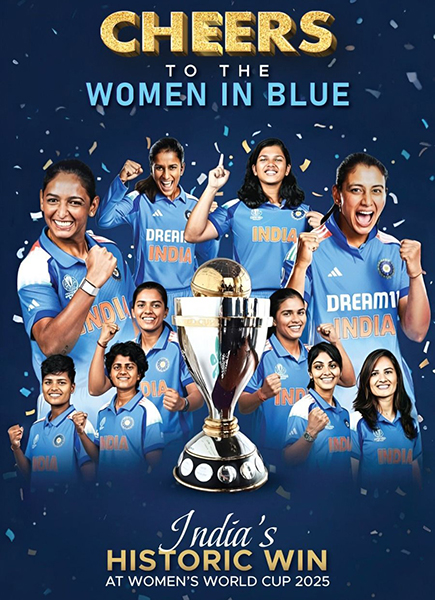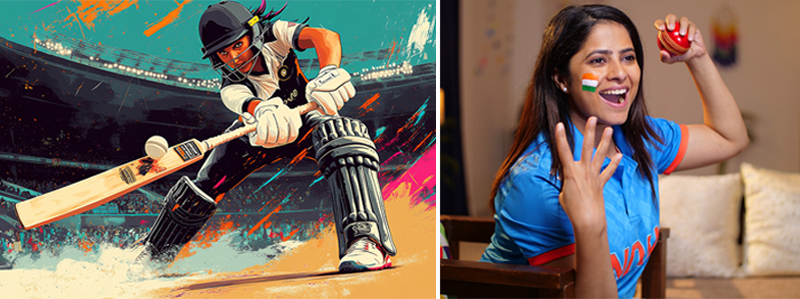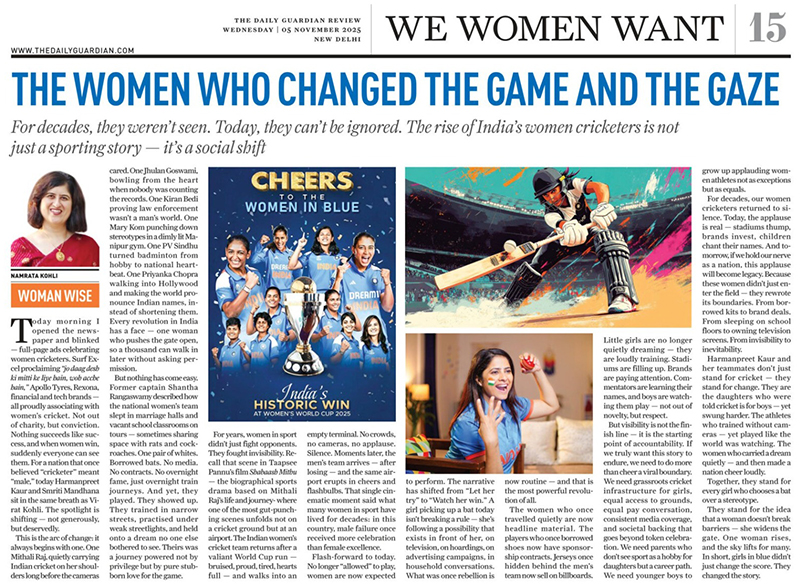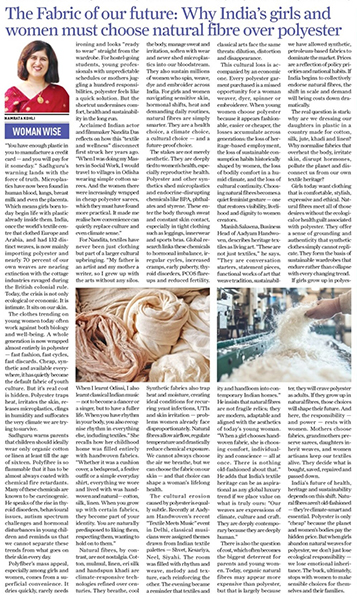For decades, they weren’t seen. Today, they can’t be ignored. The rise of India’s women cricketers is not just a sporting story — it’s a social shift
Today morning I opened the newspaper and blinked — full-page ads celebrating women cricketers. Surf Excel proclaiming “jo daag desh ki mitti ke liye hain, woh acche hain,” Apollo Tyres, Rexona, financial and tech brands — all proudly associating with women’s cricket. Not out of charity, but conviction. Nothing succeeds like success, and when women win, suddenly everyone can see them. For a nation that once believed “cricketer” meant “male,” today Harmanpreet Kaur and Smriti Mandhana sit in the same breath as Virat Kohli. The spotlight is shifting — not generously, but deservedly.
This is the arc of change: it always begins with one. One Mithali Raj, quietly carrying Indian cricket on her shoulders long before the cameras cared. One Jhulan Goswami, bowling from the heart when nobody was counting the records. One Kiran Bedi proving law enforcement wasn’t a man’s world. One Mary Kom punching down stereotypes in a dimly lit Manipur gym. One PV Sindhu turned badminton from hobby to national heartbeat. One Priyanka Chopra walking into Hollywood and making the world pronounce Indian names, instead of shortening them. Every revolution in India has a face — one woman who pushes the gate open, so a thousand can walk in later without asking permission.

But nothing has come easy.. Former captain Shantha Rangaswamy described how the national women’s team slept in marriage halls and vacant school classrooms on tours — sometimes sharing space with rats and cockroaches. One pair of whites. Borrowed bats. No media. No contracts. No overnight fame, just overnight train journeys. And yet, they played. They showed up. They trained in narrow streets, practised under weak streetlights, and held onto a dream no one else bothered to see. Theirs was a journey powered not by privilege but by pure stubborn love for the game.
For years, women in sport didn’t just fight opponents. They fought invisibility. Recall that scene in Taapsee Pannu’s film Shabaash Mithu — the biographical sports drama based on Mithali Raj’s life and journey- where one of the most gut-punching scenes unfolds not on a cricket ground but at an airport. The Indian women’s cricket team returns after a valiant World Cup run — bruised, proud, tired, hearts full — and walks into an empty terminal. No crowds, no cameras, no applause. Silence. Moments later, the men’s team arrives — after losing — and the same airport erupts in cheers and flashbulbs. That single cinematic moment said what many women in sport have lived for decades: in this country, male failure once received more celebration than female excellence.
Flash-forward to today. No longer “allowed” to play, women are now expected to perform. The narrative has shifted from “Let her try” to “Watch her win.” A girl picking up a bat today isn’t breaking a rule — she’s following a possibility that exists in front of her, on television, on hoardings, on advertising campaigns, in household conversations. What was once rebellion is now routine — and that is the most powerful revolution of all.
The women who once travelled quietly are now headline material. The players who once borrowed shoes now have sponsorship contracts. Jerseys once hidden behind the men’s team now sell on billboards. Little girls are no longer quietly dreaming — they are loudly training. Stadiums are filling up. Brands are paying attention. Commentators are learning their names, and boys are watching them play — not out of novelty, but respect.

But visibility is not the finish line — it is the starting point of accountability. If we truly want this story to endure, we need to do more than cheer a viral boundary. We need grassroots cricket infrastructure for girls, equal access to grounds, equal pay conversation, consistent media coverage, and societal backing that goes beyond token celebration. We need parents who don’t see sport as a hobby for daughters but a career path. We need younger boys to grow up applauding women athletes not as exceptions but as equals.
For decades, our women cricketers returned to silence. Today, the applause is real — stadiums thump, brands invest, children chant their names. And tomorrow, if we hold our nerve as a nation, this applause will become legacy. Because these women didn’t just enter the field — they rewrote its boundaries. From borrowed kits to brand deals. From sleeping on school floors to owning television screens. From invisibility to inevitability.
Harmanpreet Kaur and her teammates don’t just stand for cricket — they stand for change. They are the daughters who were told cricket is for boys — yet swung harder. The athletes who trained without cameras — yet played like the world was watching. The women who carried a dream quietly — and then made a nation cheer loudly.
Together, they stand for every girl who chooses a bat over a stereotype.
They stand for the idea that a woman doesn’t break barriers — she widens the gate. One woman rises, and the sky lifts for many. In short, girls in blue didn’t just change the score. They changed the story.




